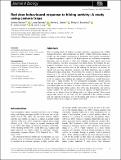Files in this item
Red deer behavioural response to hiking activity : a study using camera traps
Item metadata
| dc.contributor.author | Marion, Solene | |
| dc.contributor.author | Demšar, Urška | |
| dc.contributor.author | Davies, Althea | |
| dc.contributor.author | Stephens, Philip A. | |
| dc.contributor.author | Irvine, Justin | |
| dc.contributor.author | Long, Jed | |
| dc.date.accessioned | 2022-04-25T16:31:08Z | |
| dc.date.available | 2022-04-25T16:31:08Z | |
| dc.date.issued | 2022-08-15 | |
| dc.identifier | 278868540 | |
| dc.identifier | c6acbdc9-5b2c-44a0-b35b-af706f47ecdd | |
| dc.identifier | 85128773307 | |
| dc.identifier | 000786538000001 | |
| dc.identifier.citation | Marion , S , Demšar , U , Davies , A , Stephens , P A , Irvine , J & Long , J 2022 , ' Red deer behavioural response to hiking activity : a study using camera traps ' , Journal of Zoology , vol. 317 , no. 4 , pp. 249-261 . https://doi.org/10.1111/jzo.12976 | en |
| dc.identifier.issn | 0952-8369 | |
| dc.identifier.other | ORCID: /0000-0001-7791-2807/work/112333581 | |
| dc.identifier.other | ORCID: /0000-0002-8982-7471/work/112333685 | |
| dc.identifier.other | ORCID: /0000-0001-9774-7386/work/112334078 | |
| dc.identifier.uri | https://hdl.handle.net/10023/25243 | |
| dc.description.abstract | With increasing levels of outdoor recreation activities, consequences for wildlife through interactions with recreationists are highly variable. Behavioural changes in wildlife are one potential consequence of interactions with outdoor recreationists. In ungulate populations, vigilance and flight responses are well-known antipredator behaviours, and an increase in their level indicates a more intense stress level which, ultimately, can have consequences for animal fitness. In Scotland, the geographical distribution of red deer (Cervus elaphus) overlaps greatly with areas used for popular outdoor activities such as hill walking. In this piece of research, we studied red deer time allocation, vigilance, and flight behaviours near a popular hiking path using camera traps. We positioned the cameras in transects at different distances (25, 75, and 150 m) from the path and recorded hiking activity using an automated people counter. Red deer behaviour was categorized from photo analysis as (1) no response (e.g. feeding and resting), (2) vigilant (i.e. upright head position), and (3) flight response. We also investigated demographic variables (group size and sex) and the direction of red deer movement relative to the trail. We used generalised linear mixed models to analyse behaviour in relation to the distance from the hiking track, hiking activity, time of the day, demographic, and environmental variables. We did not find an increase in vigilance or flight behaviour in relation to the distance from the hiking path or the hiking activity. These results suggest that red deer, in our study area, are habituated to the presence of hikers and may spatially avoid areas close to the hiking path instead of displaying cost-intensive behaviour (i.e. flight or vigilance behaviour). | |
| dc.format.extent | 13 | |
| dc.format.extent | 6067396 | |
| dc.language.iso | eng | |
| dc.relation.ispartof | Journal of Zoology | en |
| dc.subject | Vigilance behaviour | en |
| dc.subject | Anthropogenic disturbance | en |
| dc.subject | Behavioural responses | en |
| dc.subject | Camera traps | en |
| dc.subject | Hiking | en |
| dc.subject | Human–wildlife interactions | en |
| dc.subject | Outdoor recreation | en |
| dc.subject | Ungulates | en |
| dc.subject | QL Zoology | en |
| dc.subject | NDAS | en |
| dc.subject.lcc | QL | en |
| dc.title | Red deer behavioural response to hiking activity : a study using camera traps | en |
| dc.type | Journal article | en |
| dc.contributor.sponsor | The British Deer Society | en |
| dc.contributor.sponsor | Carnegie Trust | en |
| dc.contributor.institution | University of St Andrews. University of St Andrews | en |
| dc.contributor.institution | University of St Andrews. Environmental Change Research Group | en |
| dc.contributor.institution | University of St Andrews. Bell-Edwards Geographic Data Institute | en |
| dc.contributor.institution | University of St Andrews. School of Geography & Sustainable Development | en |
| dc.contributor.institution | University of St Andrews. Centre for Energy Ethics | en |
| dc.contributor.institution | University of St Andrews. Geographies of Sustainability, Society, Inequalities and Possibilities | en |
| dc.identifier.doi | https://doi.org/10.1111/jzo.12976 | |
| dc.description.status | Peer reviewed | en |
| dc.identifier.grantnumber | RES2017 JI | en |
| dc.identifier.grantnumber | 70706 | en |
This item appears in the following Collection(s)
Items in the St Andrews Research Repository are protected by copyright, with all rights reserved, unless otherwise indicated.

